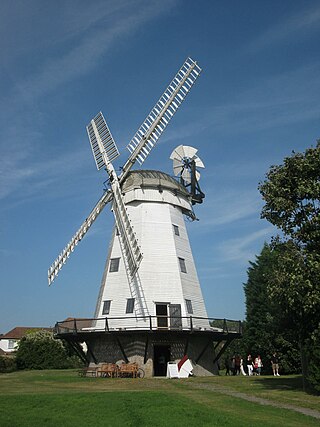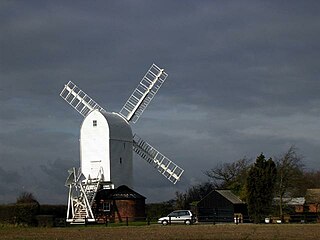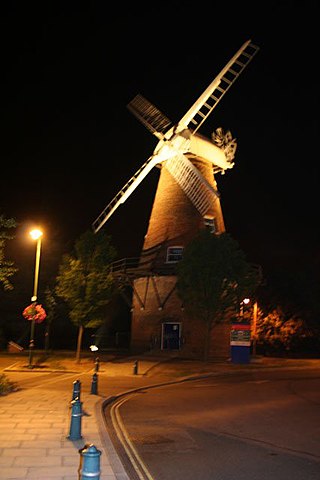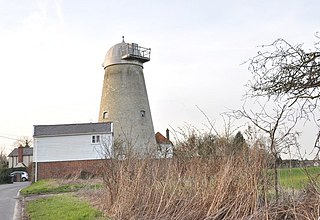
Upminster Windmill is a Grade II* listed smock mill located in Upminster in the London Borough of Havering, England. It was formerly known as Abraham's Mill and was in Essex when built. Between 2016 and 2023 the mill was restored to working order and a visitor centre was constructed. The mill and visitor centre are open to the public at selected times.

Outwood Windmill is a Grade I listed post mill in Outwood, Surrey. Built in 1665 by Thomas Budgen, a miller from Nutfield in Surrey, it is Britain's oldest working windmill. It was one of a pair after 1797, alongside a smock mill that had the tallest smock tower in the United Kingdom until its collapse in 1960.

John Webb’s or Lowe’s Mill is a Grade II* listed tower mill at Thaxted, Essex, England, which had been restored to working order, but is currently out of action following the loss of a sail in April 2010.

Shirley Windmill is a Grade II listed tower mill in Shirley, in the London Borough of Croydon, England which has been restored to working order.

Shiremark Mill, also known as Kingsfold Mill or Capel Mill was a listed Smock mill at Capel, Surrey, England, which was burnt down in 1972.

Aythorpe Roding Windmill is a Grade II* listed Post mill at Aythorpe Roding, Essex, England which has been restored to working order.

Duck End Mill, Letch's Mill or Finchingfield Post Mill is a grade II listed Post mill at Finchingfield, Essex, England which has been restored.

Ramsey Windmill is a grade II* listed post mill at Ramsey, Essex, England which has been restored.

Baker Street Mill is a grade II listed smock mill at Baker Street, Orsett, Essex, England which has been part adapted to residential use on its lower two floors only.

Terling Windmill is a grade II listed Smock mill at Terling, Essex, England, which has been converted to residential use.

South Ockendon Windmill was a Smock mill at South Ockendon, Essex, England which collapsed on 2 November 1977.
Debden Windmill is a grade II listed Tower mill at Debden, Essex, England which has been converted to residential use.

Gibraltar Mill is a grade II listed Tower mill at Great Bardfield, Essex, England which has been converted to residential use.
Church End Mill is a grade II listed Tower mill at Great Dunmow, Essex, England which has been converted to residential use.

Rayleigh Windmill is a grade II listed Tower mill at Rayleigh, Essex, England which has been restored as a landmark and is used as a museum.

Stansted Mountfitchet Windmill is a grade II* listed Tower mill at Stansted Mountfitchet, Essex, England which is also a Scheduled Ancient Monument. It has been restored and can turn by wind.

Stock Windmill is a grade II* listed tower mill at Stock, Essex, which has been restored.

Gainsford End Mill is a grade II listed tower mill at Gainsford End, near Toppesfield, Essex, England, which has been converted to a residence.

White Roding Windmill is a Grade II listed preserved tower mill at White Roding, Essex, England.


















